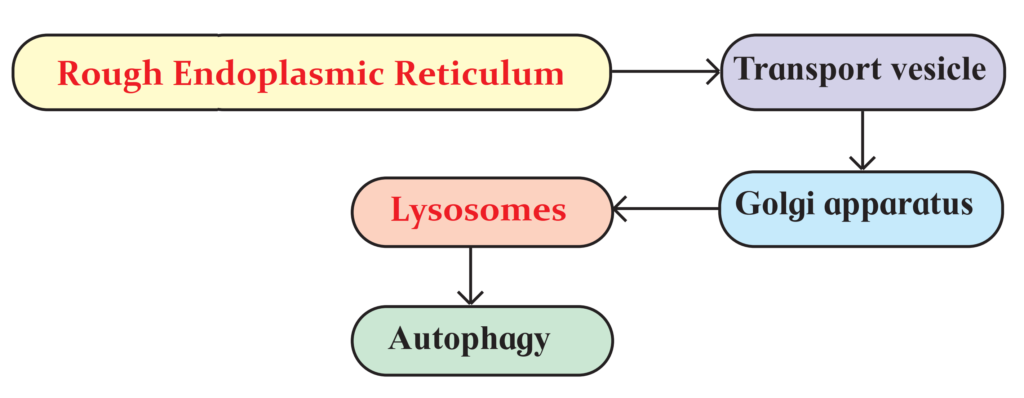1. Choose correct option.
A. Growth of cell wall during cell elongation take place by ………….
a. Apposition
b. Intussusception
c. Both a & b
d. Super position
B. Cell Membrane is composed of
a. Proteins and cellulose
b. Proteins and Phospholipid
c. Proteins and carbohydrates
d. Proteins, Phospholipid and some carbohydrates
C. Plasma membrane is Fluid structure due to presence of
a. Carbohydrates
b. Lipid
c. Glycoproteind.
d. Polysaccharide
D. Cell Wall is present in
a. Plant cell
b. Prokaryotic cell
c. Algal cell
d. All of the above
E. Plasma membrane is
a. Selectively permeable
b. Permeable
c. Impermeable
d. Semipermeable
F. Mitochondrial DNA is
a. Naked
b. Circular
c. Double stranded
d. All of the above
G. Which of the following set of organelles contain DNA?
a. Mitochondria, Peroxysome
b. Plasma membrane, Ribosome
c. Mitochondria, Chloroplast
d. Chloroplast, Golgi body
2. Answer the following questions
A. Plants have no circulatory system? Then how cells manage intercellular transport?
Ans:- (a). Plant cells show presence of plasmodesmata which are cytoplasmic bridges between neighbouring cells.
(b). This open channel through the cell wall connects the cytoplasm of adjacent plant cells and allows water, small solutes, and some larger molecules to pass between the cells. In this way, though plants have no circulatory system, plant cells manage intercellular transport.
B. Is nucleolus covered by membrane?
Ans:- A nucleolus is specialized structure present in the nucleus which is not covered by the membrane.
C. Fluid mosaic model proposed by Singer and Nicolson replaced Sandwich model proposed by Danielli and Davson? Why?
Ans:- (a). The Davson-Danielli model of the plasma membrane of a cell, was proposed in 1935 by Hugh Davson and James Danielli.
(b). The model describes a phospholipid bilayer that lies between two layers of globular proteins.
(c). This model was also known as a ‘lipo-protein sandwich’, as the lipid layer was sandwiched between two protein layers.
(d). But through experimental studies membrane proteins were discovered to be insoluble in water (representing hydrophobic surfaces) and varied in size. Such type of proteins would not be able to form an even and continuous layer around the outer surface of a cell membrane.
(e). In case of Fluid-mosaic model, the experimental evidence from research supports every major hypothesis proposed by Singer and Nicolson. This hypothesis stated that membrane lipids are arranged in a bilayer; the lipid bilayer is fluid; proteins are suspended individually in the bilayer; and the arrangement of both membrane lipids and proteins is asymmetric.
Therefore, Fluid mosaic model proposed by Singer and Nicolson replaced Sandwich model proposed by Danielli and Davson.
D. The RBC surface normally shows glycoprotein molecules. When determining blood group do they play any role?
Ans:- (a). Glycoproteins are protein molecules modified within the Golgi complex by having a short sugar chain (polysaccharide) attached to them.
(b). The polysaccharide part of glycoproteins located on the surfaces of red blood cells acts as the antigen responsible for determining the blood group of an individual.
(e). Different polysaccharide part of glycoproteins act as different type of antigens that determine the blood groups.
(f). Four types of blood groups A, B, AB, and O arc recognized on the basis of presence or absence of these antigens.
E. How cytoplasm differs from nucleoplasm in chemical composition?
Ans:- (a). A thick liquid enclosed by cell membrane which surrounds the central nucleus in eukaryotes or nucleoid region in prokaryotes is known as cytoplasm.
(b). The cytoplasm shows presence of minerals, sugars, amino acids, t-RNA, nucleotides, vitamins, proteins and enzymes.
(c). The liquid or semiliquid substance within the nucleus is called the nucleoplasm.
(d). Nucleoplasm shows presence of various substances like nucleic acid, protein molecules, minerals and salts.
3. Answer the following questions
A. Distinguish between smooth and rough endoplasmic reticulum.
Ans:- Smooth endoplasmic reticulum (SER):
(a). Depending on cell type, it helps in synthesis of lipids for e.g. Steroid secreting cells of cortical region of adrenal gland, testes and ovaries.
(b). Smooth endoplasmic reticulum plays a role in detoxification in the liver and storage of calcium ions (muscle cells).
Rough Endoplasmic Reticulum (RER):
(a). Rough ER is primarily involved in protein synthesis. For e.g. Pancreatic cells synthesize the protein insulin in the ER.
(b). These proteins are secreted by ribosomes attached to rough ER and are called secretory proteins. These proteins get wrapped in membrane that buds off from transitional region of ER. Such membrane bound proteins depart from ER as transport vesicles.
(c). Rough ER is also involved in formation of membrane for the cell. The ER membrane grows in place by addition of membrane proteins and phospholipids to its own membrane. Portions of this expanded membrane are transferred to other components of endomembrane system.
B. Mitochondria are power house of cell. Give reason.
Ans:- (a). Mitochondria possess oxysomes on its inner membrane. These oxysomes take active part in synthesis of ATP molecules.
(b). During cellular respiration, ATP molecules are produced and get accumulated in the mitochondria. They play an important role in cellular activities.
(c). Only mitochondria can convert pyruvic acid to carbon dioxide and water during cell respiration. Therefore, mitochondria arc called ‘power house of the cell’.
C. What are types of plastids?
Ans:- (a). Plastids are classified according to the pigments present in it. Three main types of plastids are – leucoplasts, chromoplasts and chloroplasts.
(b). Leucoplasts do not contain any photosynthetic pigments they arc of various shapes and sizes. These arc meant for storage of nutrients:
i. Amyloplasts store starch. ii. Elaioplasts store oils. iii. Aleuroplasts store proteins.
(c). Chromoplasts contain pigments like carotene and xanthophyll etc.
i. They impart yellow, orange or red colour to flowers and fruits.
ii. These plastids arc found in the coloured parts of flowers and fruits.
(d). Chloroplasts are plastids containing green pigment chlorophyll along with other enzymes that help in production of sugar by photosynthesis. They are present in plants, algae and few protists like Euglena.
4. Label the diagrams and write down the details of concept in your word
A.
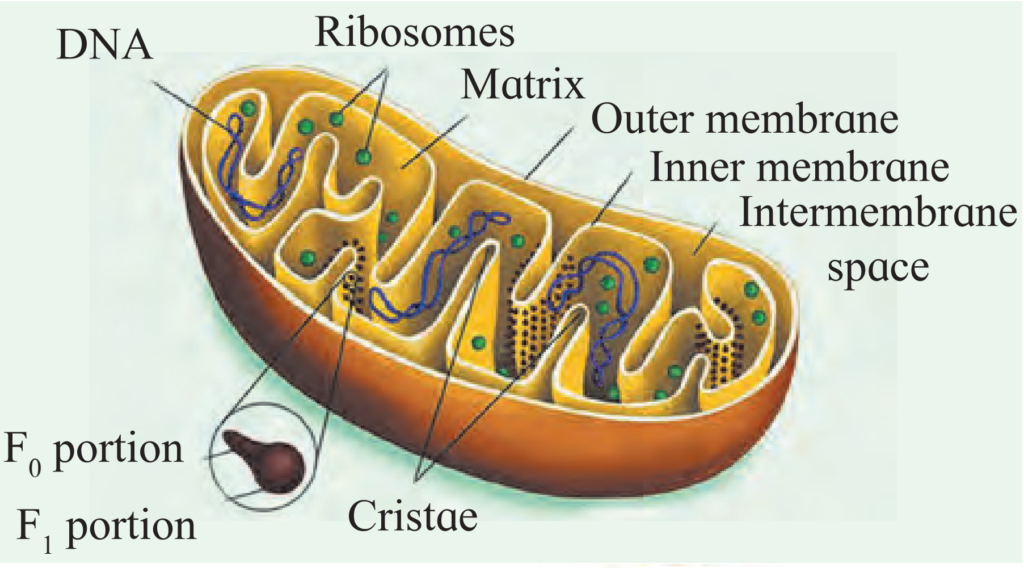
Mitochondrion is known as the power house of the cell. It plays significant role in aerobic respiration.
Mitochondria are absent in prokaryotic cells and red blood corpuscles (RBCs).
The structure of mitochondrion:
(a). Shape of the mitochondria may be oval or spherical or like spiral strip.
(b). It is a double membrane bound organelle.
(c). Outer membrane is permeable to various metabolites due to presence of a protein-Porin or Parson’s particles.
(d). Inner membrane is selectively permeable to few substances only.
(e). Both membranes are separated by intermembrane space.
(f). Inner membrane shows several finger like or plate like folds called as cristae which bears numerous particles oxysomes and cytochromes / electron carriers.
(g). Inner membrane encloses a cavity called inner chamber, containing a fluid-matrix.
(h). Matrix contains few coils of circular DNA, RNA, 70S types of ribosomes, lipids and various enzymes of Krebs’ cycle and other pathways.
B.
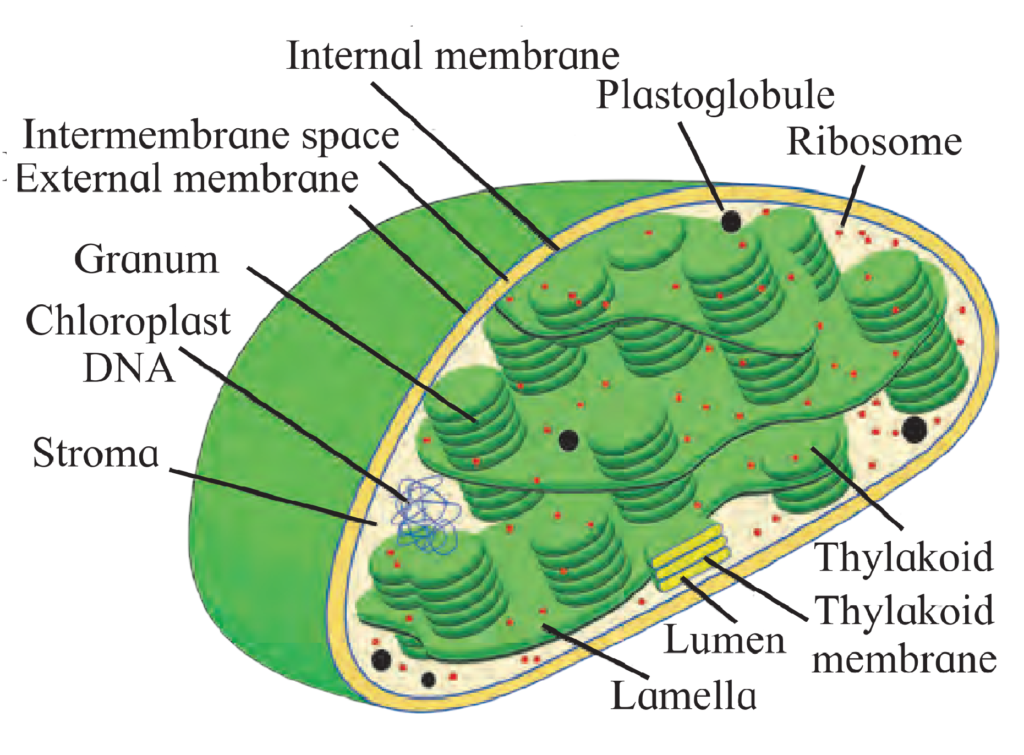
Chloroplast plays a significant role in synthesis of starch in plants
Structure of chloroplast:
(a). In plants, chloroplast is found mainly in mesophyll of leaf.
(b). Chloroplast is lens shaped but it can also be oval, spherical, discoid or ribbon like.
(c). A cell may contain single large chloroplast as in Chlamydomonas or there can be 20 to 40 chloroplasts per cell as seen in mesophyll cells.
(d). Chloroplasts contain green pigment called chlorophyll along with other enzymes that help in production of sugar by photosynthesis.
(e). Inner membrane of double membraned chloroplast is comparatively less permeable.
(f). Inside the cavity of inner membrane, there is another set of membranous sacs called thvlakoids.
(g). Thylakoids are arranged in the form of stacks called grana (singular: granum).
(h). The grana are connected to each other by means of membranous tubules called stroma lamellae.
(i). Space outside thylakoids is filled with stroma.
(j). The stroma and the space inside thylakoids contain various enzymes essential for photosynthesis.
(k). Stroma of chloroplast contains DNA and ribosomes (70S).
C.
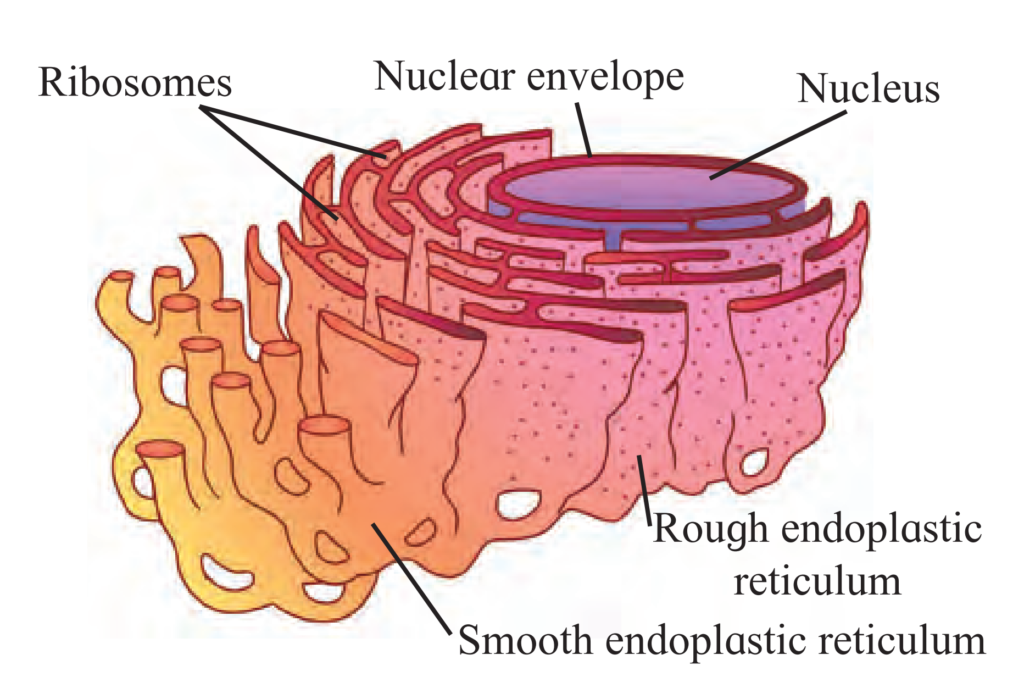
(a). Endoplasmic reticulum is a network present within the cytosol.
(b). It is present in all eukaryotic cells except ova and mature red blood corpuscles.
(c). Under the electron microscope, it appears like network of membranous tubules and sacs called cisternae.
(d). This network of ER divides the cytoplasm in two parts viz. one within the lumen of ER called laminal cytoplasm and non-laminal cytoplasm that lies outside ER.
(e). Membrane of ER is continuous with nuclear envelope at one end and extends till cell membrane. It thus acts as intracellular supporting framework and helps in maintaining position of various cell organelles in the cytoplasm.
(f). Depending upon the presence or absence of ribosomes, endoplasmic reticulum is called rough endoplasmic reticulum (RER) or smooth endoplasmic reticulum (SER) respectively.
(A). Smooth endoplasmic reticulum (SER):
(a). Depending on cell type, it helps in synthesis of lipids for e.g. Steroid secreting cells of cortical region of adrenal gland, testes and ovaries.
(b). Smooth endoplasmic reticulum plays a role in detoxification in the liver and storage of calcium ions (muscle cells).
(B). Rough Endoplasmic Reticulum (RER):
(a). Rough ER is primarily involved in protein synthesis. For e.g. Pancreatic cells synthesize the protein insulin in the ER.
(b). These proteins are secreted by ribosomes attached to rough ER and are called secretory proteins. These proteins get wrapped in membrane that buds off from transitional region of ER. Such membrane bound proteins depart from ER as transport vesicles.
(c). Rough ER is also involved in formation of membrane for the cell. The ER membrane grows in place by addition of membrane proteins and phospholipids to its own membrane. Portions of this expanded membrane are transferred to other components of endomembrane system.
D.
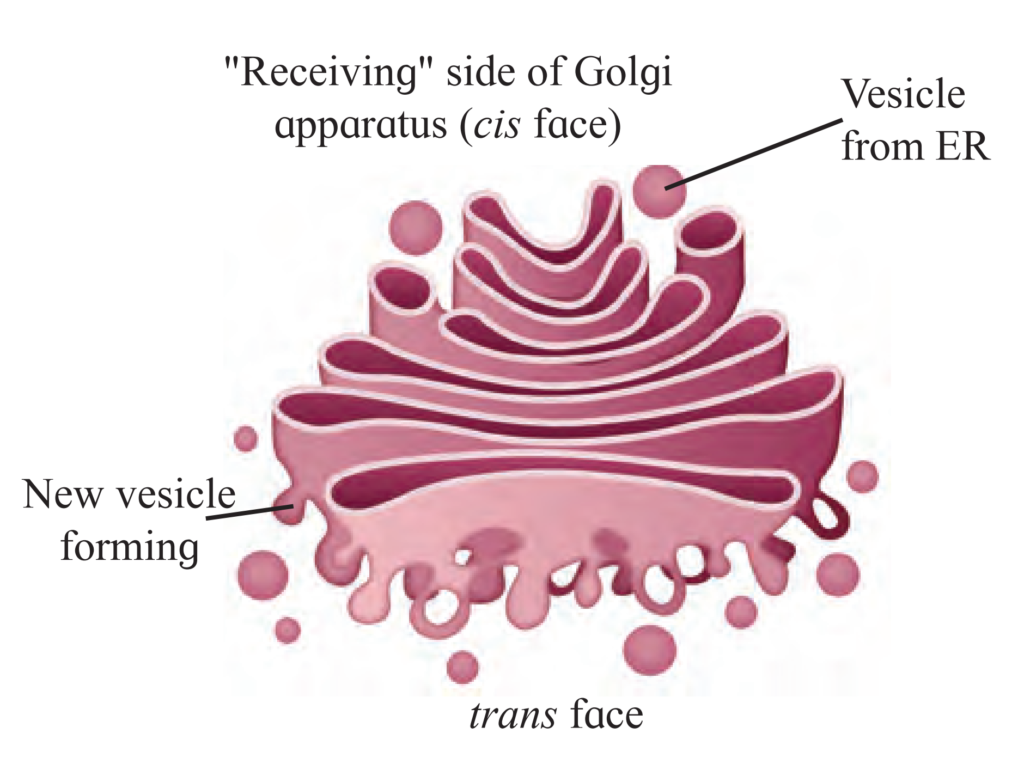
Golgi complex or Golgi apparatus or Golgi body act as a assembly, manufacturing cum packaging and transport unit of cell.
(i). Structure of Golgi complex:
(a). Golgi complex consists of stacks of membranous sacs called cisternae.
(b). Diameter of cisternae varies from 0.5 to 1pm.
(c). A Golgi complex may have few to several cisternae depending on its function.
(d). The thickness and molecular composition of membranes at one end of the stack of a Golgi sac differ from those at the other end.
(e). The Golgi sacs show specific orientation in the cell.
(f). Each cistema has a forming or ‘cis’ face (cis: on the same side) and maturing or ‘trans’ face (traits: the opposite side).
(g). Transport vesicles that pinch off from transitional ER merge with cis face of Golgi cistema and add its contents into the lumen.
(ii). Location of Golgi complex: Golgi bodies are usually located near endoplasmic reticulum.
(iii). Functions of Golgi complex:
(a). Golgi body carries out two types of functions, modification of secretions of ER and production of its own secretions.
(b). Cisternae contain specific enzymes for specific functions.
(c). Refining (modification) of product takes place in a sequential manner.
(d). For example, certain sugar component is added or removed from glycolipids and glycoproteins that are brought from ER, thus forming a variety of products.
(e). Golgi bodies also manufacture their own products. Golgi bodies in many plant cells produce noncellulose polysaccharides like pectin.
(f). Manufactured or modified, all products of Golgi complex leave cisternae from trans face as transport vesicles.
5. Complete the flow chart
Ans:
6. Label the A, B, C, and D in above diagram and write the functions of organelles A and B
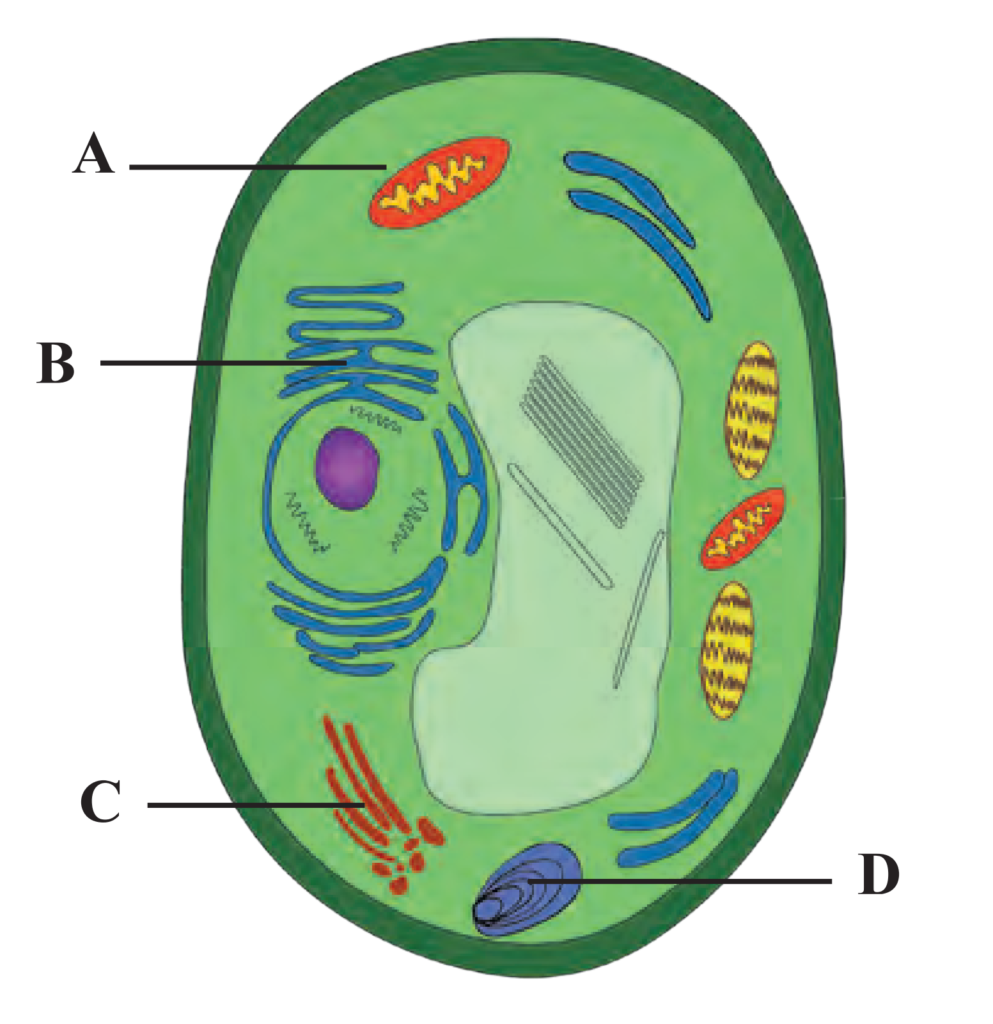
A: Mitochondria
B: Endoplasmic Reticulum
C: Golgi complex
D: Amyloplast
Functions of Mitochondria:
(a). Shape of the mitochondria may be oval or spherical or like spiral strip.
(b). It is a double membrane bound organelle.
(c). Outer membrane is permeable to various metabolites due to presence of a protein-Porin or Parson’s particles.
(d). Inner membrane is selectively permeable to few substances only.
(e). Both membranes are separated by intermembrane space.
(f). Inner membrane shows several finger like or plate like folds called as cristae which bears numerous particles oxysomes and cytochromes / electron carriers.
(g). Inner membrane encloses a cavity called inner chamber, containing a fluid-matrix.
(h). Matrix contains few coils of circular DNA, RNA, 70S types of ribosomes, lipids and various enzymes of Krebs’ cycle and other pathways.
Functions of Endoplasmic Reticulum:
Smooth endoplasmic reticulum (SER):
(a). Depending on cell type, it helps in synthesis of lipids for e.g. Steroid secreting cells of cortical region of adrenal gland, testes and ovaries.
(b). Smooth endoplasmic reticulum plays a role in detoxification in the liver and storage of calcium ions (muscle cells).
Rough Endoplasmic Reticulum (RER):
(a). Rough ER is primarily involved in protein synthesis. For e.g. Pancreatic cells synthesize the protein insulin in the ER.
(b). These proteins are secreted by ribosomes attached to rough ER and are called secretory proteins. These proteins get wrapped in membrane that buds off from transitional region of ER. Such membrane bound proteins depart from ER as transport vesicles.
(c). Rough ER is also involved in formation of membrane for the cell. The ER membrane grows in place by addition of membrane proteins and phospholipids to its own membrane. Portions of this expanded membrane are transferred to other components of endomembrane system.
7. Identify each cell structure or organelle from it’s description below.
i. Manufactures/ generates ribosomes
Ans: Nucleolus
ii. Carry out photosynthesis
Ans: Chloroplast
iii. Manufactures ATP in animal and plant cells
Ans: Mitochondria
iv. Selectivelly permeable
Ans: Plasma membrane
8. Onion cells have no chloroplast. How can we tell they are plants?
Ans:
(a). The bulb of an onion is a modified form of leaves.
(b). While photosynthesis takes place in the leaves (present above the ground) of an onion containing chloroplast, the little glucose that is produced from this process is converted in to starch (starch granules) and stored in the bulb.
(c). Starch act as reserved food material in plants.
(d). Using an iodine solution, we can test for the presence of starch in onion cells. If starch is present, the iodine changes from brown to blue-black or purple. Hence, we can say that though onion cells have no chloroplast they are considered as plants.
